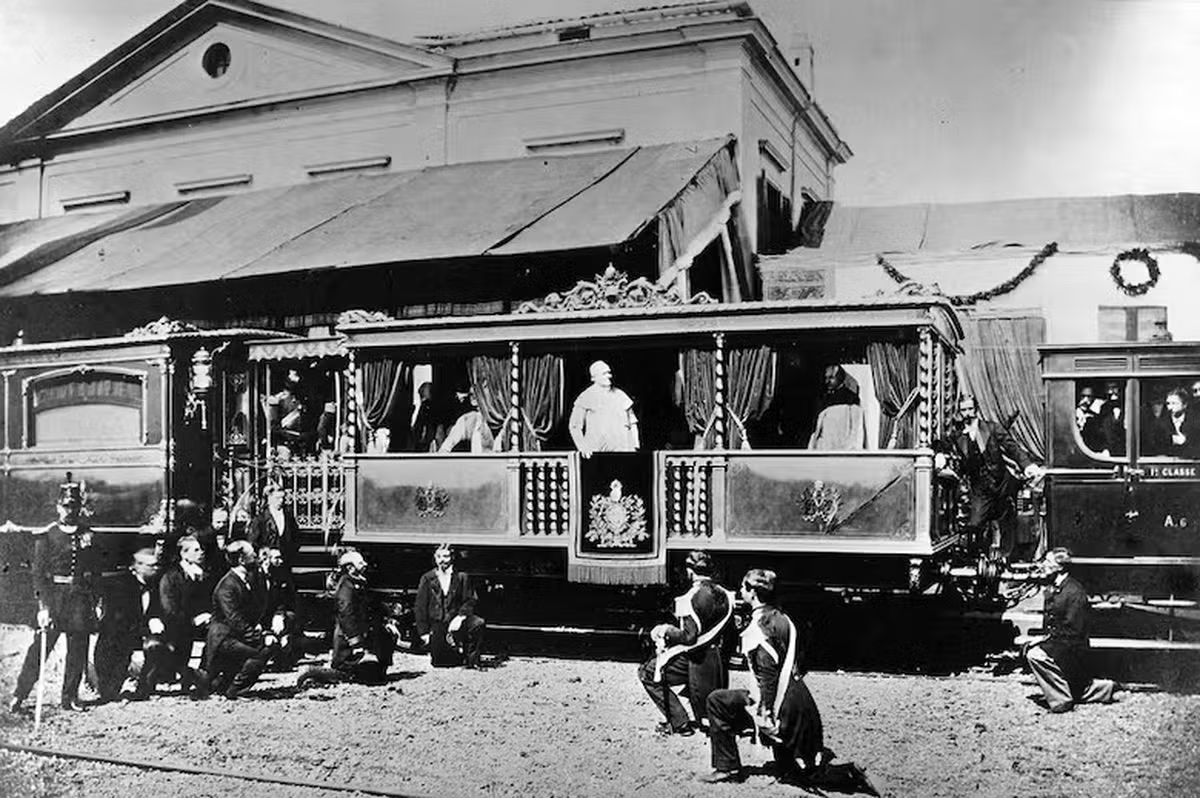
“Railroads, the road to hell.” This was the motto of the conservative Pope Gregory XVI, who preceded Pius IX. The Industrial Revolution created tensions in several sectors and brought about changes in production processes, industrial relations, and means of transportation. When Giovanni Maria Mastai Ferretti became Pope in 1846, railways were beginning to be seen as the transportation of the future, and he wanted to embrace this modernity.
- In search of our ancestors: An expedition on the coast of Uruguay begins researching the microorganisms that gave birth to life. understand
Rome-Velletri-Ceprano and Rome-Ancona-Bologna. In this scenario, Pio Centrale and Pio Latina, the companies responsible for the railway lines within the Papal States, were planning to gift the Pope with their trains.
It was built in France in 1858 at a cost of 140,000 francs and consisted of three vehicles, each with a specific function. The first two, the Throne Coach and Balcony Coach, also known as the Loggia delle Benedizioni, were created by the company Delettrez et Compagnie.
The third vehicle, known as the Chapel Car, was built at the Compagnie Générale des Matériels de Chemins de Fer’s facilities in Paris to the design of engineer and architect Emile Torella. Its ceiling was adorned with a fresco by Jean-Léon Gérôme and Charles-Antoine Cambon depicting the Pope inaugurating trains and ships, symbolizing the Pope’s intention to present himself as a modern leader.
See details inside the Pope Pius IX train
/i.s3.glbimg.com/v1/AUTH_da025474c0c44edd99332dddb09cabe8/internal_photos/bs/2025/g/X/Vbc80GSsy94CuuZ5xvCQ/image-2025-11-11t090231.688.png)
1 out of 6
Pope Pius IX — Photo: Reproduction
/i.s3.glbimg.com/v1/AUTH_da025474c0c44edd99332dddb09cabe8/internal_photos/bs/2025/a/e/AmtkkwS9WWyVAU0vQdXQ/image-2025-11-11t090257.284.png)
/i.s3.glbimg.com/v1/AUTH_da025474c0c44edd99332dddb09cabe8/internal_photos/bs/2025/a/e/AmtkkwS9WWyVAU0vQdXQ/image-2025-11-11t090257.284.png)
2/6
Richly decorated chapel carriages often failed to fulfill their function — Photo: Reproduction/La Nacion
/i.s3.glbimg.com/v1/AUTH_da025474c0c44edd99332dddb09cabe8/internal_photos/bs/2025/D/Z/o5K9pcSQOR4jvWWoREZQ/image-2025-11-11t090351.604.png)
/i.s3.glbimg.com/v1/AUTH_da025474c0c44edd99332dddb09cabe8/internal_photos/bs/2025/D/Z/o5K9pcSQOR4jvWWoREZQ/image-2025-11-11t090351.604.png)
3/6
Access to the train was via a staircase inside the carriage, which had a balustraded terrace where the Pope welcomed and blessed the faithful. — Photo: Reproduction/La Nacion
/i.s3.glbimg.com/v1/AUTH_da025474c0c44edd99332dddb09cabe8/internal_photos/bs/2025/j/W/mCtG8VR3CcU16QElMRVg/image-2025-11-11t090430.858.png)
4/6
The Romans were so surprised that when they were transported to the Braschi Palace in 1951, they stopped to watch the carriages of the papal train pass by. — Photo: Reproduction
/i.s3.glbimg.com/v1/AUTH_da025474c0c44edd99332dddb09cabe8/internal_photos/bs/2025/o/e/BRvBaTRFC5pAHi6uYGTQ/image-2025-11-11t090525.638.png)
5/6
Complete configuration from when it was still in operation. First the chapel, then the throne carriage (the most private one) and finally the Loggia delle Benedizioni. — Photo: Reproduction
/i.s3.glbimg.com/v1/AUTH_da025474c0c44edd99332dddb09cabe8/internal_photos/bs/2025/d/I/nmCZYmRxWmXWmhoVh7oA/image-2025-11-11t090556.855.png)
6/6
Famous photo: Pope Pius IX resting at Velletri station. It was his last official journey by rail in 1863. — Photo: Reproduction
Built in France in 1858, this train transported the Pope through the cities of the Papal States and became a symbol of the fusion of religious tradition and technological innovation.
The chapel car was the most ornate and was equipped with an altar and liturgical furniture, allowing the Pope to celebrate Mass during his travels. The throne car, with its yellow and white upholstery, was more enclosed and modest, intended for official meetings and long-distance journeys, and served as a place of work and rest.
The third carriage, the Balcony or Panoramic Car, had open windows and Solomonic columns, giving it the appearance of a “mobile loggia.” From there, Pius IX was able to greet and bless the faithful at the train station, getting closer to the people than ever before. One of the carriages had the Pope’s coat of arms painted in large letters.
Horse-drawn carriages were transported from France to Italy in 1859, first up the Rhone to Marseilles, then by sea to Civitavecchia, and then to Ripa Grande south of the Tiber. Pius IX made his maiden voyage on July 3, 1859, leaving Rome’s Porta Maggiore station for Cecchina station (Albano) near Castel Gandolfo.
This first visit marked the beginning of a series of papal trips through the territory, taking advantage of the innovative rail infrastructure championed by the pope himself. The last trip carrying the Pope was from Rome to Frosinone in 1863, and was recorded in a famous photograph at Velletri station.
Around 1870, the Papal States came to an end with the occupation of Rome by Italian forces. With the unification of Italy, the trains were decommissioned, first in Civitavecchia and then at Termini station, where some of their decorations were removed and they were abandoned.
From oblivion to recovery
It was not until 1911, when it was exhibited at Castel Sant’Angelo to commemorate the 50th anniversary of Italian unification, that the train was recognized as a historical artifact. The state-owned company Ferrovie dello Stato took over its recovery and carried out initial conservation restoration.
Around 1930, the state donated the train to the city of Rome, which transferred it to the Roman Museum on Via Cerchi. On August 8, 1951, the carriage was taken to its new headquarters in Palazzo Braschi in a parade that impressed the Romans, even forcing them to widen the opening in the façade of Piazza Navona.
In 2010, the train was transferred to the Centrale Montemartini, an archaeological museum that is part of the Capitoline Museums and housed in a former thermoelectric power plant, where it has been on display in Boiler Room 2 since 2016. The contrast between classical statues and large obsolete machinery creates a fascinating dialogue between antiquity and modernity.
This year, to coincide with Jubilee, the story of the Papal Train was featured in the interactive exhibition “Le Vie del Giubileo” held at Villa Farnesina, exploring the relationship between pilgrims, trains and the Pope throughout history, and highlighting the value of trains as symbols of faith, power and innovation.


